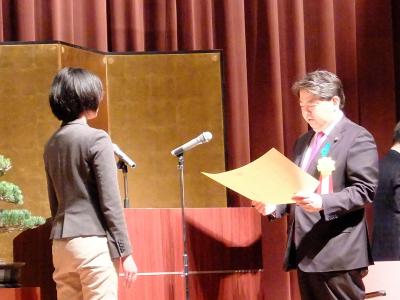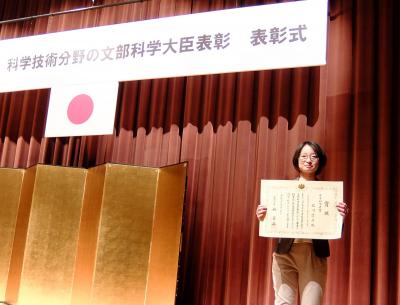Dr. Ryohko Ishikawa Receives the MEXT Minister's Award in Science and Technology for Young Scientists
Dr. Ryohko Ishikawa, an assistant professor in the SOLAR-C Project Office of NAOJ has received the FY2018 MEXT Minister's Award in Science and Technology for Young Scientists. The subject of her research is "Observational Research in magnetic fields of the Sun utilizing the observational instruments launched into space." Using the data from the solar observing satellite Hinode, she discovered the Transient Horizontal Magnetic Fields which exist all over the Sun. She showed that they are generated by a new dynamo mechanism driven by turbulent convection near the solar surface and that the amount of energy harbored by those newly discovered magnetic fields is sufficient to explain the coronal heating. She also contributed to the success of the international sounding rocket experiment CLASP as a leading member of its development and pioneered a new method of ultraviolet spectropolarimetry to measure magnetic fields in the upper solar atmosphere.
This award is given by the MEXT Minister to young scientists who have achieved remarkable results which show advanced research and development ability, such as germinating new research and research based on creative viewpoints. The commendation ceremony was held at MEXT on April 17, 2018. Dr. Ishikawa received an award certificate directly from the MEXT Minister, representing the 99 young scientist award winners.
Quote from Dr. Ryohko Ishikawa:
I am very happy and encouraged by receiving an honorable award for the scientific results from the solar observing satellite Hinode and the sounding rocket experiment CLASP, both of which demonstrate Japan's strong position in the scientific world. I am grateful to my predecessors, coworkers, and students who have conducted research and experiments together with me; and to my family who support both my mind and body.
Explanation of Awarded Research
Magnetic fields are thought to be involved in the mechanism by which energy is transferred from the solar surface to the corona, raising the coronal temperature to more than 1 million K. To reveal the coronal heating mechanism, it is essential to observationally investigate the details of the magnetic fields which extend from the solar surface to the corona.
◇Discovery of Transient Horizontal Magnetic Fields with the solar observing satellite Hinode
Using the data for the magnetic fields at the solar surface precisely measured by the solar observing satellite Hinode, Dr. Ishikawa discovered magnetic fields different from those harbored by sunspots. These magnetic fields, which she named transient horizontal magnetic fields (THMF's), exist all over the Sun. She proposed that the THMF's are generated by a new dynamo mechanism in which magnetic field lines are elongated and amplified by the convection near the solar surface. She also showed that the amount of energy harbored by THMF's is sufficient to cover the coronal heating. THMF's have attracted researchers' attention as an important research target to solve the mystery of coronal heating.
◇Pioneering a new method to measure the magnetic fields of the upper solar atmosphere by the sounding rocket experiment CLASP
In order to understand the mechanism of coronal heating, information on the magnetic fields in the upper solar atmosphere is essential in addition to those at the solar surface. However, as they go up, it becomes difficult to measure the magnetic fields since their strength becomes weaker. Dr. Ishikawa and her colleagues carried out a sounding rocket experiment CLASP, developing a new observational instrument to obtain information on the magnetic fields in the upper layers of the solar atmosphere, called the chromosphere and the transition region, by observing the polarization of ultraviolet rays emitted from those atmospheric layers. They launched the instrument with a sounding rocket and carried out observations. By analyzing the observational data, Dr. Ishikawa found the polarization signature which originates from the magnetic fields in the chromosphere and the transition region. This means that ultraviolet spectropolarimetry has opened a new window to measure solar magnetic fields. Dr. Ishikawa is now leading development of the observational instrument for the re-flight experiment CLASP2 as PI of the Japanese team of the project.
Regarding the use of images and movies on the page concerned, please visit the page here. The credits of images and movies on this page are “NAOJ/JAXA” unless explicitly stated to the contrary. Regarding images and movies on this page the credits of which are “NAOJ/JAXA”, "NAOJ/JAXA/MSU", or “NAOJ, JAXA, NASA/MSFC”, terms of use for Copyrighted Works owned by NAOJ can be applied. In using the images and movies, the credits should be given.


